|
The Museum of a Style
by Bob
Brooke
 The
Ecole de Nancy Museum is one of the few museums dedicated to an
artistic movement----Art Nouveau. It’s located in the heart of
Nancy, France, in the former residence Eugène Corbin, an important
collector of artworks from the Ecole de Nancy. The
Ecole de Nancy Museum is one of the few museums dedicated to an
artistic movement----Art Nouveau. It’s located in the heart of
Nancy, France, in the former residence Eugène Corbin, an important
collector of artworks from the Ecole de Nancy.
The City of Nancy acquired the Corbin residence between 1951 and
1952. On June 26, 1964, the museum opened to the public. However, at
the time, people considered the Art Nouveau style ofd-fashioned.
Inside the house, furniture, works of art, glassware, ceramics,
stained glass, paintings and fabrics illustrate the diversity of
techniques worked by artists from the École de Nancy. Representative
of “Art for all”, these are small inlaid pieces of furniture,
acid-etched glass or mass-produced ceramics.
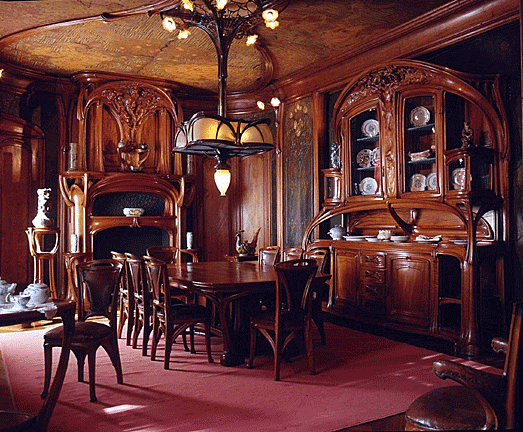
The museum presents the essence of the Art Nouveau Era. Visitors enter
the world of Art Nouveau. This isn’t a reconstruction of the 1900 era
but an interpretation of the time by restoring the atmosphere of the
period. Many of the works on display are by Émile Gallé, including over
400 pieces of art glass, as well as works of ceramics and furniture.
The museum also contains the dining room designed between 1903 and 1906
by Eugène Vallin, in collaboration with Victor Prouvé for the painted
ceiling as well as the leather hangings and the Daum Glass factory for
the lights. In addition to the great names of the Ecole de Nancy , the
museum offers an overview of the French Art Nouveau movement with works
by Guimard, Chaplet, Selmersheim and Carabin.
 Villa
Majorelle is a great example of the Art Nouveau unity of art concept
advocated by the artists who are members of the Ecole de Nancy. It was
the first Art Nouveau house in Nancy. Built between 1901 and 1902 for
the artist Louis Marjorelle. A collaboration between Parisian and Nancy
artists and the architect Henri Sauvage, who solicited the work of
Jacques Gruber for the stained glass windows, Alexandre Bigot for the
sandstones, Francis Jourdain and Henri Royer for the paintings, and
Louis Majorelle, himself, for the ironwork, woodwork and furniture. Villa
Majorelle is a great example of the Art Nouveau unity of art concept
advocated by the artists who are members of the Ecole de Nancy. It was
the first Art Nouveau house in Nancy. Built between 1901 and 1902 for
the artist Louis Marjorelle. A collaboration between Parisian and Nancy
artists and the architect Henri Sauvage, who solicited the work of
Jacques Gruber for the stained glass windows, Alexandre Bigot for the
sandstones, Francis Jourdain and Henri Royer for the paintings, and
Louis Majorelle, himself, for the ironwork, woodwork and furniture.
Nearly 100 pieces of furniture, paintings and works of art from the
collections of the Ecole de Nancy museum. It contains some pieces
originally from the house, plus others chosen to recreate the atmosphere
of an Art Nouveau interior.
The Museum’s Collections
The extent of the museum's collections reflects the diversity of fields
developed by the Ecole de Nancy . The Art Nouveau Movement was able to
excel in the decorative arts, but it also distinguished itself in
painting, sculpture, graphic arts and photography.
Glass
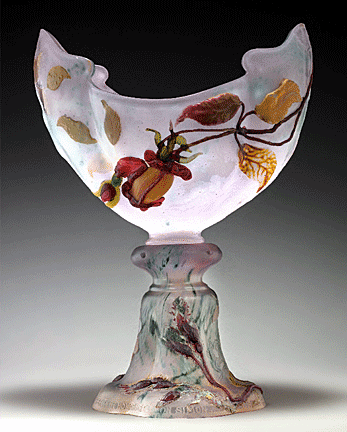 The
Ecole de Nancy was best known for its art glass, which benefits from
ancient know-how in Lorraine. The Museum displays glass—both objects as
well as stained glass---associated with furniture and works of art, with
the exception of pieces by Émile Gallé which have their own gallery. The
Ecole de Nancy was best known for its art glass, which benefits from
ancient know-how in Lorraine. The Museum displays glass—both objects as
well as stained glass---associated with furniture and works of art, with
the exception of pieces by Émile Gallé which have their own gallery.
The museum houses more than 400 works by Émile Gallé, including pieces
chosen by him in 1903 which makes it possible for visitors to view the
evolution of the artist from transparent glass, decorated with painted
or gilded motifs, towards increasingly colored glass, playing on
material effects and applications. Galle combined innovation and
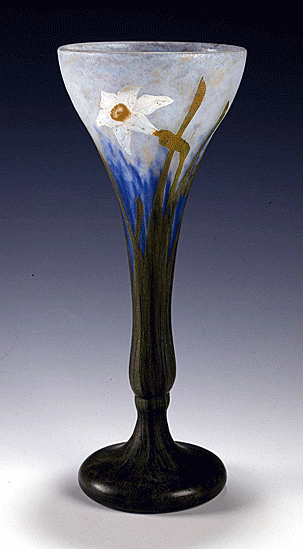 artistic
research drawing on the nature. The museum's collection contains
masterpieces such as the vase Les hommes noirs, displayed at the
Exhibition Universelle of 1900, and the Roses de France cup, made in
1901 . artistic
research drawing on the nature. The museum's collection contains
masterpieces such as the vase Les hommes noirs, displayed at the
Exhibition Universelle of 1900, and the Roses de France cup, made in
1901 .
Brothers Auguste and Antoin Daum followed Émile Gallé’s example,
developing their own glass creations, experimenting with other
techniques such as glass paste and adapting them to methods of mass
production. The museum 's Daum collection includes more than 150 pieces,
from the creation of an artistic department within the company in 1891
until the 1920s, as well as showing the range of techniques they used,
including colorings, powders, applications, hammering, and engraving.
Stained Glass
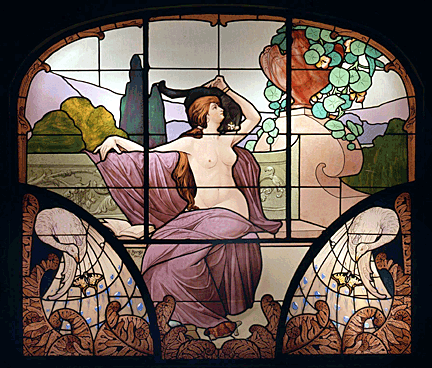 The
artists of the Ecole de Nancy wanted to renew all the decorative arts
and stained glass benefitted from this. The Museum has around 150
stained glass windows dating from the end of the 19th century to the eve
of the Second World War. The
artists of the Ecole de Nancy wanted to renew all the decorative arts
and stained glass benefitted from this. The Museum has around 150
stained glass windows dating from the end of the 19th century to the eve
of the Second World War.
Stained glass acted as a barrier between the outside and the inside. It
absorbed the sun's rays and restored part of it, creating a colored
light, giving interiors an atmosphere often likened to an aquarium. It
may have been necessary to mask a mediocre environment using opaque
glass. Or give the illusion of a garden for the Les Roses stained glass
window designed for the Corbin house. On the other hand, architects
lined the openings of the verandas, bow windows or windows overlooking
the garden with non-opaque stained glass, which made it possible to take
advantage of the surrounding nature.

Technical innovations contributed to the decorative rendering of the
glass. Artists superimposed layers of glass, etched it with acid, plus
used different types of glass together to create decorative paintings.
Although many Art Nouveau stained glass windows featured plant motifs,
the human figure was often present.
Lamps
With the advent of electricity, the artists of Nancy created the first
models of lighting, to be placed or suspended. The permanent collections
present several examples, which contribute to the restoration of the
atmosphere of a 1900 dwelling. Émile Gallé became interested in lamps in
1902 and turned to nature for his inspiration. The stem and leaves of a
plant inspired its frame, while the flowers and seeds decorated the base
and its support.
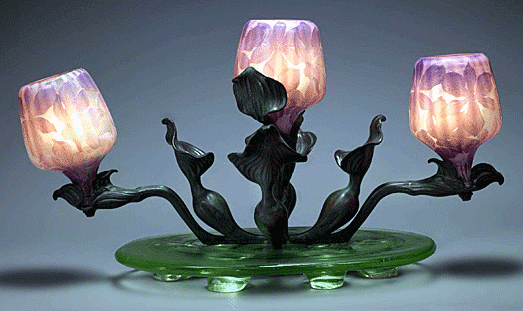
Pottery
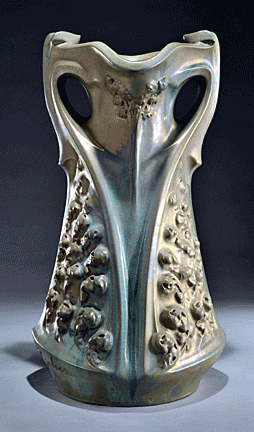 Even
though potters in the Lorraine region long had a mastery of ceramics
well before Art Nouveau, Artists Émile Gallé, Louis Majorelle, the
Mougin brothers worked with local potteries to modernize techniques. The
permanent collections allow visitors to discover the diversity of
stoneware and earthenware produced at that time. Even
though potters in the Lorraine region long had a mastery of ceramics
well before Art Nouveau, Artists Émile Gallé, Louis Majorelle, the
Mougin brothers worked with local potteries to modernize techniques. The
permanent collections allow visitors to discover the diversity of
stoneware and earthenware produced at that time.
Gallé's collection of ceramics includes more than 250 works. Until 1893,
the artist designed earthenware pieces of great diversity in shapes and
decorations. The latter draw as much from the Middle Ages and Rococo as
from ancient Egypt and Japan.
Furniture
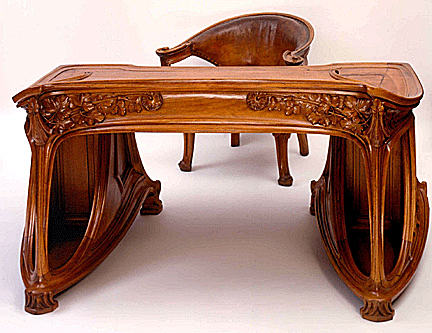 Furniture
played a major role in the renewal of Art Nouveau living environments.
Furniture is on display in various living rooms: dining room, bedroom,
office, and library settings. Furniture
played a major role in the renewal of Art Nouveau living environments.
Furniture is on display in various living rooms: dining room, bedroom,
office, and library settings.
Émile Gallé not only created art glass but also pieces of furniture
inspired by nature, both in the inlaid patterns and in the shapes. The
centerpiece of the museum, the Dawn and Twilight bed, made between 1903
and 1904, is an example of the cabinetmaker's latest technical and
artistic advances.
The Majorelle collection includes furniture decorated with inlaid
panels. A desk, a pedestal table and a bookcase combining mahogany and
gilt bronze on the theme of water lilies, is an example of the evolution
of Majorelle's production in 1900.
<
Back to More Antiques to View
Next Article > |
